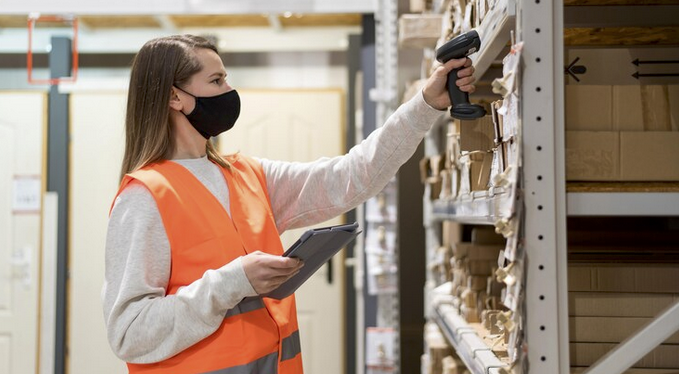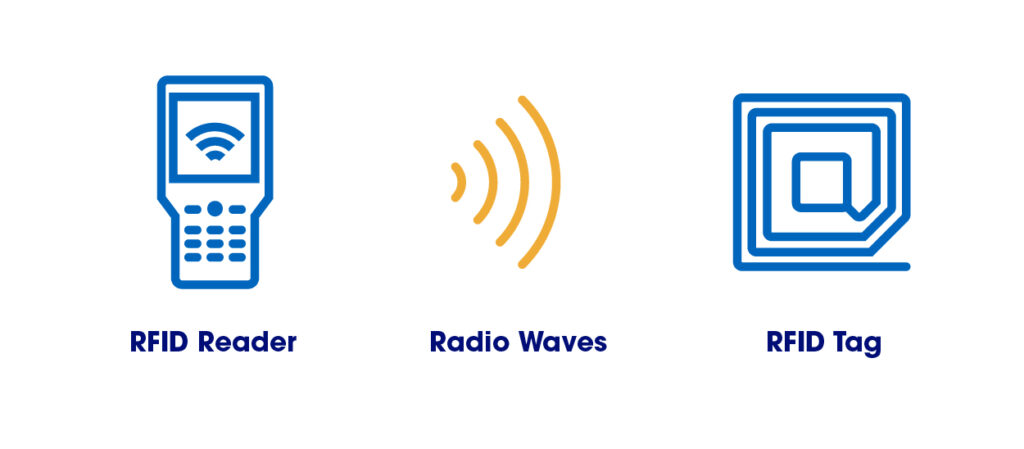In 2005, The University of Pittsburgh Medical Center (UPMC), which operates 30 hospitals, more than 600 doctors’ offices, and outpatient centers, established its own central warehouse to easily store and distribute medicines and medical products and eliminate the middleman.
The UPMC Distribution Center employs over 60 people, spans 150,000 square feet, and stocks over 4,000 SKUs. It operates 24/5, handling over 2.3 million lines and 250,000 cross-docked parcels annually. With 9 delivery vehicles covering over 490,000 miles each year, these figures reflect UPMC’s need for an optimized warehouse system. UPMC implemented RFID technology to track every product, integrating them into several storage and distribution operations for a seamless and well-monitored warehouse.
Radio Frequency Identification (RFID) technology has become a pivotal instrument not just in UPMC, but also in warehouse and logistics, deftly revolutionizing how retailers track and manage inventory. RFID provides improved inventory tracking accuracy and streamlines processes that enhance warehouse efficiency.
However, as with any innovation, adopting RFID has its considerations and challenges. In this article, we delve into the intricacies of RFID technology, exploring its pros and cons in the context of warehouse management. Through a comprehensive analysis, retailers can gain invaluable insights to navigate the decision-making process effectively. By fully understanding the technology, businesses can harness the full potential of RFID in warehouse management.
- How RFID in Warehouse Management Works
- The Core Benefits of RFID in Warehouse Management
- Understanding the Challenges of RFID in Warehouse Management
How RFID in Warehouse Management Works
Radiofrequency identification, as the name implies, is powered by radio waves. RFID tags may interact with reader devices even when they are not in direct line of sight. The reader can exchange the information with software like the warehouse’s inventory management system.
An RFID system has three main components that work together to be able to provide crucial data:
- RFID label
- RFID reader
- a computer or phone with integrated software and database
A transponder included in the RFID tag uses radio waves to communicate recorded data. This data can be SKU information used for inventory management in warehousing. The data is then sent to and processed by the RFID reader, which combines a transceiver and scanning antenna to read the data from the RFID tag.
There are two varieties of RFID Tags on the market: active and passive.
Active RFID tags are perfect for tracking high-value items over long distances. They come with a power supply and transmitter, have a 100-meter operating range, and can send data at a speed of one to two seconds.
Passive RFID tags, on the other hand, do not require a power supply and instead rely on the radio waves that the reader antenna emits. They are ideal for tracking low-value items since they are less expensive and require minimal upkeep.
A computer system can decode and identify what is being read by RFID scanners. It interprets the information and presents it in a readable manner. You can then compare the data logged by RFID scanners with the inventory information kept in your central database.
The range of RFID tags varies. Unlike traditional barcode scanning, which needs a scanner to “see” the barcode directly, RFID tagging does not require line-of-sight. The kind of tag, the reader used, and possible interference all factor into an RFID’s effective scanning range. Certain RFID tags can be scanned from farther away than others. SKUs, lot numbers, serial numbers, and other data may be saved, scanned, and updated in real-time.
The Core Benefits of RFID in Warehouse Management
Supply chains must deal with endless operational difficulties and quick market changes. This has led to a growing demand for accurate, automated data collection using RFID in warehouse management. Fulfillment facilities trying to improve data collection accuracy, efficiency, and flow have succeeded with RFID technology. In addition, the system has clear advantages over manual and barcode data-gathering techniques.
By utilizing RFID technology, warehouses can perform processes more quickly, accurately, and efficiently. Facilities that use more efficient procedures save on operating costs and increase total output.
1.Precise Inventory Management
RFID-enabled automated data collection supplies your warehouse management system (WMS) with essential data, including SKU numbers, locations, and quantities. Fixed and portable readers can gather data from an RFID tag placed on a pallet or product and send it to your ERP or WMS. This real-time data stream gives you important insights into the movements and whereabouts of your inventory.
You may also monitor products when they travel between different warehouse zones or separate facilities. It can be customized depending on how sophisticated your RFID positioning system is. In turn, this saves time spent attempting to locate pallets and SKUs and produces an accurate record of your inventory
2. Item Verification at Receiving and Releasing
By placing RFID readers at dock doors, you can simultaneously scan items as they are loaded and unloaded, removing the need for guesswork. Using an RFID system with passive tags and fixed readers, you can quickly confirm the product and its amount as it passes through a checkpoint.
Moreover, if the items scanned in don’t match the shipment you were meant to receive, RFID software can immediately notify you. RFID checkpoints can detect shipment problems and increase your facility’s fulfillment accuracy throughout the outbound process.
3. Accurate Automated Workflows
RFID tags can be read quickly and precisely, making it possible to automate many routine warehouse tasks. Businesses may reduce time spent on cycle counts, put-away, receiving goods, shipping, handling returns, and other operations by integrating RFID into warehouse management. RFID automation reduces the risk of human error from manual warehouse procedures. It also frees up labor and time, allowing you to re-focus these resources on other essential parts of the business.
When warehouses rely less on an unstable labor supply, they may operate leaner and more efficiently. An effective RFID system also alerts users when mistakes occur, such as misplacing inventory, putting the incorrect item on a pallet, or shipping the incorrect cargo to a customer. Warehouses can employ RFID as a quality assurance technique. Greater visibility leads to more streamlined and effective operations. It can also minimize costly mistakes that occur from manual methods.
4. Precise Stock Management
RFID automatically tracks inventory and controls stock levels. It’s a great way to manage the enormous volumes of items that come and go from your warehouse daily. RFID software can help keep stock levels at ideal levels by alerting users when limits are exceeded for overstocking or understocking.
RFID stock management can offer up-to-date information on product models, sizes, quantities, and other details. Even the difficult task of controlling stock levels can be made easier for goods with expiration dates and sensitive environmental conditions like temperature. Advanced RFID tags can keep track of dates and temperatures, alerting you for any changes.
In addition to simplifying inventory management, RFID in warehouse management can enforce quality assurance procedures and standards for product integrity.
5. Warehouse Equipment and Parts Tracking
RFID in the warehouse may be used for more than just inventory control. RFID technology is also useful for monitoring the movement of essential tools, equipment, and other supplies.
Businesses can maintain an extensive chain of custody and maximize equipment usage. Keep a close eye on your vital equipment with an asset management platform. It will also help you better handle loss prevention.
Understanding the Challenges of RFID in Warehouse Management
As with all innovations, businesses encounter several obstacles and challenges in some tech implementation. Despite all its benefits, RFID isn’t for everyone. So, take the time to understand the potential complications you might encounter when implementing RFID in your warehouse.
1. Expensive to implement
RFID tags are significantly more expensive than barcode labels. The cost of individual tags is reasonably high since they have more components. For many tags, their internal batteries are non-replaceable. The entire tag needs to be replaced every three to five years.
Furthermore, they use specialized readers only available for purchase from several RFID equipment manufacturers. When scaling with these systems, you’ll need more scanners and RFID tags, which might result in an exponential increase in your expenses.
2. Cybersecurity Concerns
RFID systems are vulnerable to hacking, even with ongoing updates and improvements to their data security. In some situations, remote devices—including cell phones—can copy tag data and scan tags up close. This risk is especially concerning for the retail sector. Bad actors might use the duplicate information to add details to another tag or make a cloned tag later.
3. Demanding Infrastructure Needs
Setting up RFID systems in the warehouse might take a lot of time and resources. This technology involves the integration of building wiring, inventory management software, readers, and tags.
Keeping up with the volume of data that RFID tags can provide may be a daunting task in and of itself. You’ll need powerful servers to manage the massive volume of data. You might also want to consider setups that take in specific data and discard others.
RFID can save time and money for businesses searching for cutting-edge solutions to enhance their warehouse inventory management. However, they may also be more expensive or complicated than what is reasonable for your company. If you’re considering using RFID in warehouse management, you need an expert solutions company to help you decipher which technology can be cost-effective and provide the most significant outcome for your business and can
Aratum is your partner for successfully implementing RFID in warehouse management. Our complete supply chain management software suite gives you full control over your warehouse’s data. Fully secured and scalable, we offer complete integrations with RFID scanning solutions. Jadwalkan demo and discover how our software optimizes your warehouse processes.


